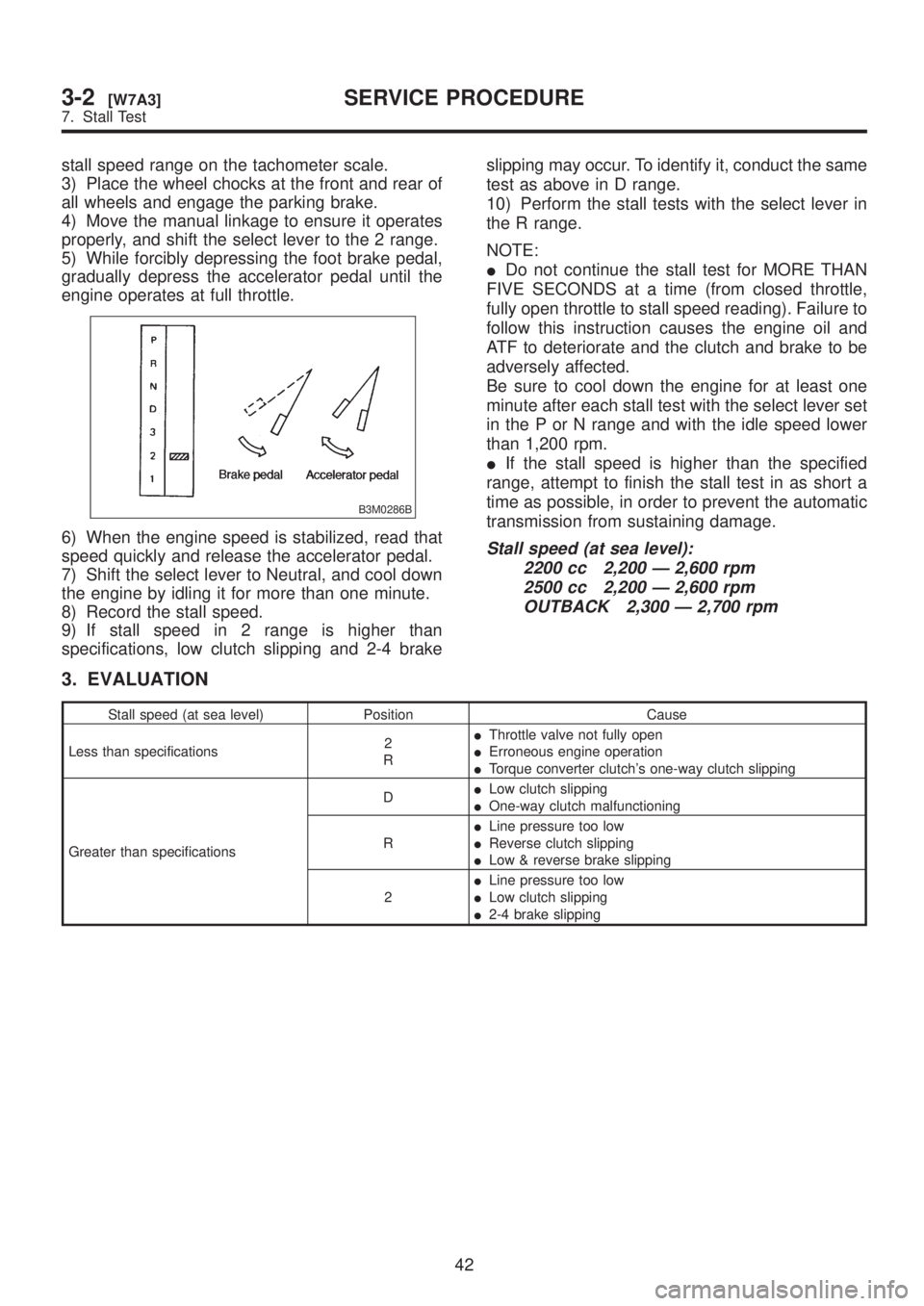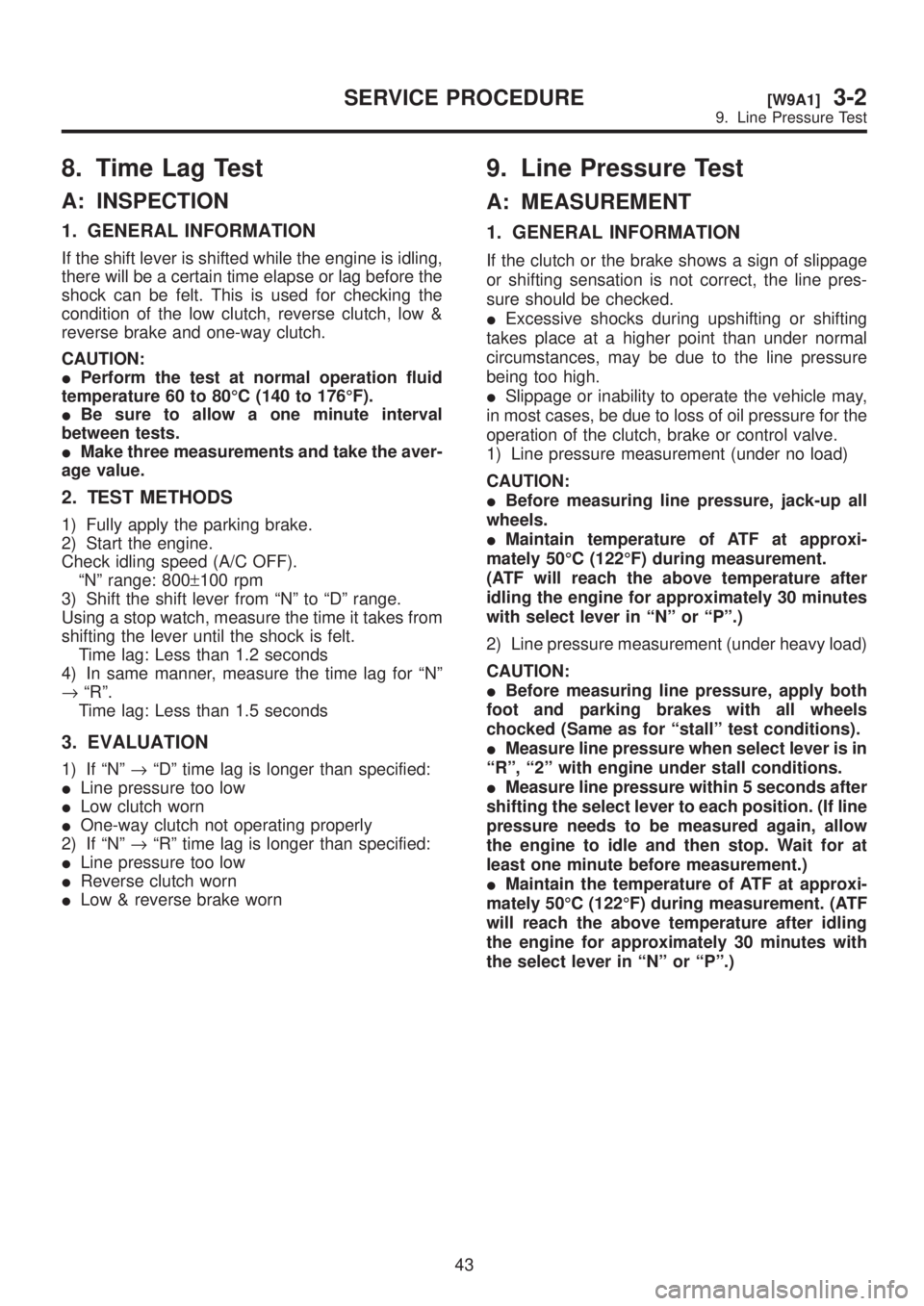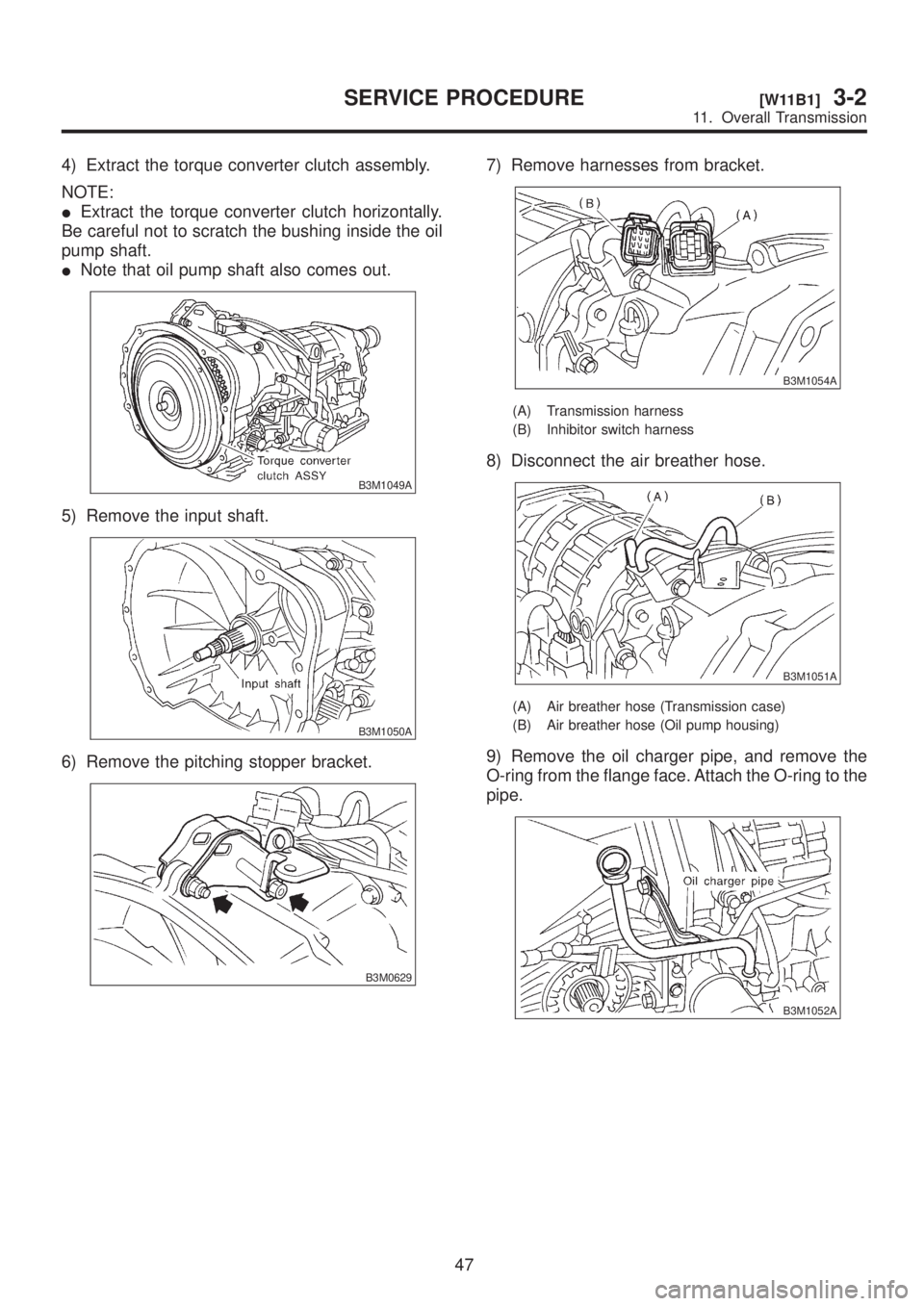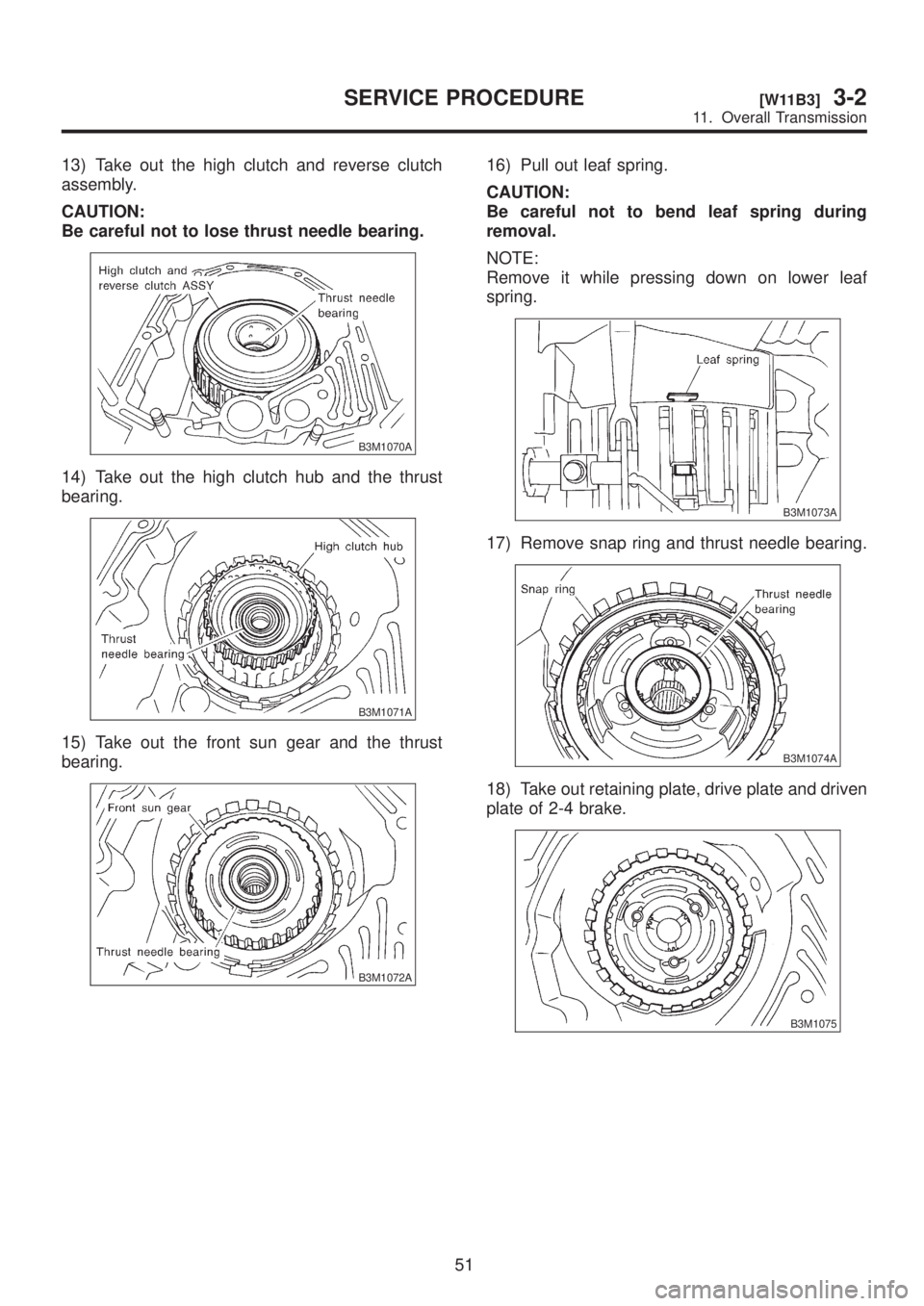1999 SUBARU LEGACY clutch
[x] Cancel search: clutchPage 570 of 1456

stall speed range on the tachometer scale.
3) Place the wheel chocks at the front and rear of
all wheels and engage the parking brake.
4) Move the manual linkage to ensure it operates
properly, and shift the select lever to the 2 range.
5) While forcibly depressing the foot brake pedal,
gradually depress the accelerator pedal until the
engine operates at full throttle.
B3M0286B
6) When the engine speed is stabilized, read that
speed quickly and release the accelerator pedal.
7) Shift the select lever to Neutral, and cool down
the engine by idling it for more than one minute.
8) Record the stall speed.
9) If stall speed in 2 range is higher than
specifications, low clutch slipping and 2-4 brakeslipping may occur. To identify it, conduct the same
test as above in D range.
10) Perform the stall tests with the select lever in
the R range.
NOTE:
IDo not continue the stall test for MORE THAN
FIVE SECONDS at a time (from closed throttle,
fully open throttle to stall speed reading). Failure to
follow this instruction causes the engine oil and
ATF to deteriorate and the clutch and brake to be
adversely affected.
Be sure to cool down the engine for at least one
minute after each stall test with the select lever set
in the P or N range and with the idle speed lower
than 1,200 rpm.
IIf the stall speed is higher than the specified
range, attempt to finish the stall test in as short a
time as possible, in order to prevent the automatic
transmission from sustaining damage.Stall speed (at sea level):
2200 cc 2,200 Ð 2,600 rpm
2500 cc 2,200 Ð 2,600 rpm
OUTBACK 2,300 Ð 2,700 rpm
3. EVALUATION
Stall speed (at sea level) Position Cause
Less than specifications2
RIThrottle valve not fully open
IErroneous engine operation
ITorque converter clutch's one-way clutch slipping
Greater than specificationsDILow clutch slipping
IOne-way clutch malfunctioning
RILine pressure too low
IReverse clutch slipping
ILow & reverse brake slipping
2ILine pressure too low
ILow clutch slipping
I2-4 brake slipping
42
3-2[W7A3]SERVICE PROCEDURE
7. Stall Test
Page 571 of 1456

8. Time Lag Test
A: INSPECTION
1. GENERAL INFORMATION
If the shift lever is shifted while the engine is idling,
there will be a certain time elapse or lag before the
shock can be felt. This is used for checking the
condition of the low clutch, reverse clutch, low &
reverse brake and one-way clutch.
CAUTION:
IPerform the test at normal operation fluid
temperature 60 to 80ÉC (140 to 176ÉF).
IBe sure to allow a one minute interval
between tests.
IMake three measurements and take the aver-
age value.
2. TEST METHODS
1) Fully apply the parking brake.
2) Start the engine.
Check idling speed (A/C OFF).
ªNº range: 800±100 rpm
3) Shift the shift lever from ªNº to ªDº range.
Using a stop watch, measure the time it takes from
shifting the lever until the shock is felt.
Time lag: Less than 1.2 seconds
4) In same manner, measure the time lag for ªNº
®ªRº.
Time lag: Less than 1.5 seconds
3. EVALUATION
1) If ªNº®ªDº time lag is longer than specified:
ILine pressure too low
ILow clutch worn
IOne-way clutch not operating properly
2) If ªNº®ªRº time lag is longer than specified:
ILine pressure too low
IReverse clutch worn
ILow & reverse brake worn
9. Line Pressure Test
A: MEASUREMENT
1. GENERAL INFORMATION
If the clutch or the brake shows a sign of slippage
or shifting sensation is not correct, the line pres-
sure should be checked.
IExcessive shocks during upshifting or shifting
takes place at a higher point than under normal
circumstances, may be due to the line pressure
being too high.
ISlippage or inability to operate the vehicle may,
in most cases, be due to loss of oil pressure for the
operation of the clutch, brake or control valve.
1) Line pressure measurement (under no load)
CAUTION:
IBefore measuring line pressure, jack-up all
wheels.
IMaintain temperature of ATF at approxi-
mately 50ÉC (122ÉF) during measurement.
(ATF will reach the above temperature after
idling the engine for approximately 30 minutes
with select lever in ªNº or ªPº.)
2) Line pressure measurement (under heavy load)
CAUTION:
IBefore measuring line pressure, apply both
foot and parking brakes with all wheels
chocked (Same as for ªstallº test conditions).
IMeasure line pressure when select lever is in
ªRº, ª2º with engine under stall conditions.
IMeasure line pressure within 5 seconds after
shifting the select lever to each position. (If line
pressure needs to be measured again, allow
the engine to idle and then stop. Wait for at
least one minute before measurement.)
IMaintain the temperature of ATF at approxi-
mately 50ÉC (122ÉF) during measurement. (ATF
will reach the above temperature after idling
the engine for approximately 30 minutes with
the select lever in ªNº or ªPº.)
43
[W9A1]3-2SERVICE PROCEDURE
9. Line Pressure Test
Page 572 of 1456

8. Time Lag Test
A: INSPECTION
1. GENERAL INFORMATION
If the shift lever is shifted while the engine is idling,
there will be a certain time elapse or lag before the
shock can be felt. This is used for checking the
condition of the low clutch, reverse clutch, low &
reverse brake and one-way clutch.
CAUTION:
IPerform the test at normal operation fluid
temperature 60 to 80ÉC (140 to 176ÉF).
IBe sure to allow a one minute interval
between tests.
IMake three measurements and take the aver-
age value.
2. TEST METHODS
1) Fully apply the parking brake.
2) Start the engine.
Check idling speed (A/C OFF).
ªNº range: 800±100 rpm
3) Shift the shift lever from ªNº to ªDº range.
Using a stop watch, measure the time it takes from
shifting the lever until the shock is felt.
Time lag: Less than 1.2 seconds
4) In same manner, measure the time lag for ªNº
®ªRº.
Time lag: Less than 1.5 seconds
3. EVALUATION
1) If ªNº®ªDº time lag is longer than specified:
ILine pressure too low
ILow clutch worn
IOne-way clutch not operating properly
2) If ªNº®ªRº time lag is longer than specified:
ILine pressure too low
IReverse clutch worn
ILow & reverse brake worn
9. Line Pressure Test
A: MEASUREMENT
1. GENERAL INFORMATION
If the clutch or the brake shows a sign of slippage
or shifting sensation is not correct, the line pres-
sure should be checked.
IExcessive shocks during upshifting or shifting
takes place at a higher point than under normal
circumstances, may be due to the line pressure
being too high.
ISlippage or inability to operate the vehicle may,
in most cases, be due to loss of oil pressure for the
operation of the clutch, brake or control valve.
1) Line pressure measurement (under no load)
CAUTION:
IBefore measuring line pressure, jack-up all
wheels.
IMaintain temperature of ATF at approxi-
mately 50ÉC (122ÉF) during measurement.
(ATF will reach the above temperature after
idling the engine for approximately 30 minutes
with select lever in ªNº or ªPº.)
2) Line pressure measurement (under heavy load)
CAUTION:
IBefore measuring line pressure, apply both
foot and parking brakes with all wheels
chocked (Same as for ªstallº test conditions).
IMeasure line pressure when select lever is in
ªRº, ª2º with engine under stall conditions.
IMeasure line pressure within 5 seconds after
shifting the select lever to each position. (If line
pressure needs to be measured again, allow
the engine to idle and then stop. Wait for at
least one minute before measurement.)
IMaintain the temperature of ATF at approxi-
mately 50ÉC (122ÉF) during measurement. (ATF
will reach the above temperature after idling
the engine for approximately 30 minutes with
the select lever in ªNº or ªPº.)
43
[W9A1]3-2SERVICE PROCEDURE
9. Line Pressure Test
Page 574 of 1456

10. Transfer Clutch Pressure
Test
A: MEASUREMENT
1. TEST METHODS
Check transfer clutch pressure in accordance with
the following chart in the same manner as with line
pressure.
ST 499897700 OIL PRESSURE ADAPTER
SET
ST 498575400 OIL PRESSURE GAUGE
ASSY
AWD mode: ªDº range
FWD mode: ªPº range, engine speed 2,000 rpm
CAUTION:
Before setting in FWD mode, install spare fuse
on FWD mode switch.
B3M1047
2. EVALUATION
NOTE:
If oil pressure is not produced or if it does not
change in the AWD mode, the duty solenoid C or
transfer valve assembly may be malfunctioning. If
oil pressure is produced in the FWD mode, the
problem is similar to that in the AWD mode.
Standard transfer clutch pressure kPa (kg/cm2, psi)
Duty ratio
(%)AWD mode FWD mode
5951 Ð 1,089
(9.7 Ð 11.1, 138 Ð 158)Ð
60226 Ð 294
(2.3 Ð 3.0, 33 Ð 43)Ð
95 Ð 0 (0, 0)
45
[W10A2]3-2SERVICE PROCEDURE
10. Transfer Clutch Pressure Test
Page 576 of 1456

4) Extract the torque converter clutch assembly.
NOTE:
IExtract the torque converter clutch horizontally.
Be careful not to scratch the bushing inside the oil
pump shaft.
INote that oil pump shaft also comes out.
B3M1049A
5) Remove the input shaft.
B3M1050A
6) Remove the pitching stopper bracket.
B3M0629
7) Remove harnesses from bracket.
B3M1054A
(A) Transmission harness
(B) Inhibitor switch harness
8) Disconnect the air breather hose.
B3M1051A
(A) Air breather hose (Transmission case)
(B) Air breather hose (Oil pump housing)
9) Remove the oil charger pipe, and remove the
O-ring from the flange face. Attach the O-ring to the
pipe.
B3M1052A
47
[W11B1]3-2SERVICE PROCEDURE
11. Overall Transmission
Page 577 of 1456

10) Remove the oil cooler inlet and outlet pipes.
CAUTION:
When removing outlet pipes, be careful not to
lose balls and springs used with retaining
screws.
B3M1053A
2. SEPARATION OF EACH SECTION
1) Separation of torque converter clutch case and
transmission case sections
CAUTION:
IBe careful not to damage the oil seal and
bushing inside the torque converter clutch
case by the oil pump cover.
IBe careful not to lose the rubber seal.
NOTE:
Separate these cases while tapping lightly on the
housing.
B3M1055A
2) Separation of transmission case and extension
sections
(1) Remove vehicle speed sensor 1 (rear).
B3M1056A
(2) Separation of transmission case and exten-
sion case sections
B3M1057A
3. TRANSMISSION CASE SECTION
1) Remove the reduction driven gear.
(1) Straighten the staked portion, and remove
the lock nut.
NOTE:
Set the range selector lever to ªPº.
B3M1058A
(2) Using the ST1 and ST2, extract the reduc-
tion driven gear.
NOTE:
ST1 499737000 PULLER
ST2 899524100 PULLER SET
B3M0954A
48
3-2[W11B2]SERVICE PROCEDURE
11. Overall Transmission
Page 579 of 1456

6) Remove the oil pan.
NOTE:
Use a scraper to remove oil pan.
B3M1065A
7) Disconnect the harness connectors for the
solenoids, duty solenoids, ATF temperature sensor
and the ground cord.
B2M2263C
(A) Lock-up duty solenoid (Blue)
(B) Low clutch timing solenoid (Gray)
(C) Line pressure duty solenoid (Red)
(D) Shift solenoid 2 (Yellow)
(E) Shift solenoid 1 (Green)
(F) 2-4 brake timing solenoid (Black)
(G) 2-4 brake duty solenoid (Red)
(H) ATF temperature sensor
8) Remove the control valve body.
CAUTION:
When removing control valve body, be careful
not to interfere with transfer duty solenoid C
wiring.
B3M1037A
9) Remove vehicle speed sensor 2 (front) and
torque converter turbine speed sensor.
B3M1066A
10) Remove transmission harness.
B3M1067A
11) Remove the oil pump housing.
CAUTION:
Be careful not to lose the total end play adjust-
ing thrust washer.
B3M1068A
12) Remove 2-4 brake seal.
B3M1069A
50
3-2[W11B3]SERVICE PROCEDURE
11. Overall Transmission
Page 580 of 1456

13) Take out the high clutch and reverse clutch
assembly.
CAUTION:
Be careful not to lose thrust needle bearing.
B3M1070A
14) Take out the high clutch hub and the thrust
bearing.
B3M1071A
15) Take out the front sun gear and the thrust
bearing.
B3M1072A
16) Pull out leaf spring.
CAUTION:
Be careful not to bend leaf spring during
removal.
NOTE:
Remove it while pressing down on lower leaf
spring.
B3M1073A
17) Remove snap ring and thrust needle bearing.
B3M1074A
18) Take out retaining plate, drive plate and driven
plate of 2-4 brake.
B3M1075
51
[W11B3]3-2SERVICE PROCEDURE
11. Overall Transmission